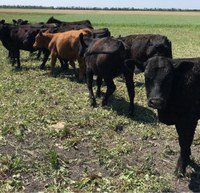Grazing/Harvesting Rule Change to Benefit Producers
(Click the image below to view a high-resolution image that can be downloaded)
Changes in federal grazing and harvesting rules on prevented-planting acres could help North Dakota livestock producers replenish forage supplies or at least offset shortages in perennial forage production, according to North Dakota State University Extension livestock specialists.
The U.S. Department of Agriculture (USDA) will allow producers to graze, hay or cut cover crops on prevented-planting acres beginning Sept. 1.
“Many livestock producers in the region are short on forage following a long, cold winter and late spring that depleted forage supplies,” says Kevin Sedivec, Extension rangeland management specialist. “Supplies in some areas have been further exacerbated due to low forage production resulting from cool temperatures and drought.”
The change in the allowable harvesting or grazing date to Sept. 1 on prevented-planting acres gives livestock producers an opportunity to offset the shortage of forage supplies.
“Flexibility in choosing a cover crop mixture becomes greater and strategies for what to plant can be tailored to fit your intended need,” says Miranda Meehan, Extension livestock environmental stewardship specialist. “With an earlier release date, landowners can plant different mixtures that can be used for grazing, haying or silage/haylage while providing soil health benefits.”
If Grazing is the Goal
Producers have many opportunities to plant a cover crop mixture to be used for grazing.
“Your selection of species to use should be based on when you want to graze and if you want to hay first, then graze,” Meehan explains. “The mixtures can be simple to very complex, depending on budget, soil health goals and species of livestock.”
If plans are to graze in September, seed a mixture containing cool-season cereals (oats, barley, triticale), warm-season grasses (soughum-sudan, sudangrass, foxtail millet), brassicas (turnip, radish, rape, kale, cabbage), broadleaf plants (sunflower, buckwheat) and legumes (forage peas, faba beans, lentils, clovers, vetch).
“Your options are plentiful, but select based on production needs, minimal inputs, seed costs and availability, and overall budget,” Meehan advises.
If plans are to graze after Oct. 15, the seed mixture options could include cool-season cereals (oats, barley, triticale), foxtail millet, brassicas (turnip, radish, kale), broadleaf plants (sunflower, buckwheat) and legume (forage peas, clovers, vetch).
“It is important to have a good grazing management plan in place to avoid potential animal health issues associated with cover crops,” says Janna Block, Extension livestock systems specialist at NDSU’s Hettinger Research Extension Center. “Many species used in cover crops are known to accumulate nitrates and also may have toxic levels of sulfur.
“Sorghum and sudangrass also can accumulate prussic acid, particularly during drought,” she adds. “Cover crops may be low in magnesium, which can result in development of grass tetany. Bloat can occur with legumes or if protein levels are too high in the mixture.”
If using brassicas in a mix for grazing, the general recommendation is to limit them to less than 50% of the seed mixture to avoid digestive disorders in cattle. Provide livestock with dry hay or other forage prior to turnout, and gradually introduce them to cover crops during a period of several days if possible.
If Haying is the Goal
The selection of plant species to be hayed after Sept. 1 becomes limited due to lack of drying conditions and the plants’ ability to dry sufficiently to make high-quality hay. Forage plants need to be nonhigh water-holding plants and have small stems for greater potential to cure in September or later.
Recommended species for September haying include cool-season cereals (oats, barley, triticale), warm-season grasses (foxtail millet, sudangrass) and legumes (forage peas, clovers and vetch). The cereal grains and warm-season grasses can be seeded in monocultures or mixtures with or without the legume. This mixture will be a better choice if plans are to graze after harvesting.
If Silage/Haylage is the Goal
More options can be added to this mixture because drying to an acceptable level for curing isn’t as critical. Harvesting before a freeze is important to achieve silage because desired moisture conditions need to be 65% to 70% for a bunker and 60% to 68% for silo bags.
A hard freeze will reduce the moisture content dramatically within 24 to 48 hours. Haylage can be put up at a lower moisture level (40% to 60%), so harvesting in late September to early October is possible.
Recommended species for silage and haylage include warm-season grasses (sorghum, sorghum sudangrass hybrid, pearl millet), cool-season cereals (oats, barley, triticale), brassicas (kale, cabbage, turnips) and legumes (forage peas). The warm-season grasses can be seeded in monocultures or mixtures with the cool-season grasses, brassicas and/or legumes.
A mixture will be a better choice if plans are to graze after harvesting, but it usually results in less tonnage of forage. If haylage will be your final feed produced, eliminate the brassicas in the mixture because they will be difficult to dry to less than 60% before mid-October and the other plants in the mixture will be too dry following a hard frost.
Crop producers intending on planting cover crops on prevented-planting acres to suppress weeds and enhance soil health have an opportunity to market this forage to livestock producers. The NDSU Feedlist (https://www.ag.ndsu.edu/feedlist) can connect crop producers with livestock producers in search of additional forage.
Meehan recommends producers get a laboratory analysis for any cover crop mixture prior to feeding it to livestock.
“Due to this one-time rule change granted by the USDA, creating a high-quality feed will be possible on prevented-planting acres in 2019,” Sedivec says. “Take advantage of this opportunity. Plant a cover crop that can enhance your soil health while creating feed for late-season grazing or hay and silage/haylage production.”
NDSU Agriculture Communication - July 8, 2019
| Source: | Kevin Sedivec, 701-424-3606, kevin.sedivec@ndsu.edu |
|---|---|
| Source: | Miranda Meehan, 701-231-7683, miranda.meehan@ndsu.edu |
| Source: | Janna Block, 701-567-4323, janna.block@ndsu.edu |
| Editor: | Ellen Crawford, 701-231-5391, ellen.crawford@ndsu.edu |


